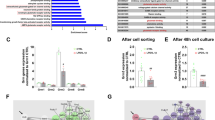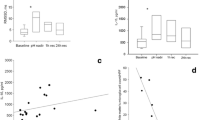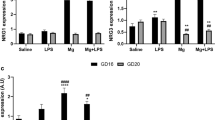Abstract
The efferent and afferent effects of the vagus nerve on the developing brain have remained enigmatic. Here we review the evidence of such effects on microglial plasticity in the sheep model of human fetal development, one of the most recognized and deployed models of human fetal physiology. We show that vagotomy alters microglial phenotype and that this effect is hormetic under conditions of mild systemic inflammation, as may occur antepartum with chorioamnionitis. We present the methodology to assess not only biomarker-based microglial activation (Iba-1), but also the morphometric features of the microglia. Together, these assessments provide a more comprehensive toolbox of glial phenotypical characterizations, especially in the context of investigating the locoregional vagal control of glial function. The presented findings support the earlier discoveries in preclinical and clinical models of adult physiology whereby vagotomy appeared neuroprotective for Parkinson’s, explained, at least in part, by the effects on microglia. In addition, we present the approach to measure and the findings on regional cerebral blood flow changes in relation to vagus nerve manipulation. Together, the body of evidence underscores the importance of both the efferent and the afferent vagal pathways, via the vagus nerve, in the programming of microglial phenotype in the developing brain. The significance of these relationships for the development and treatment of early susceptibility to neuroinflammatory and neurodegenerative disorders in later life requires further studies.
Access this chapter
Tax calculation will be finalised at checkout
Purchases are for personal use only
Similar content being viewed by others
Notes
- 1.
Who watches the watchers?
References
Pavlov VA, Tracey KJ (2022) Bioelectronic medicine: preclinical insights and clinical advances. Neuron. https://doi.org/10.1016/j.neuron.2022.09.003
Frasch MG et al (2016) Decreased neuroinflammation correlates to higher vagus nerve activity fluctuations in near-term ovine fetuses: a case for the afferent cholinergic anti-inflammatory pathway? J Neuroinflammation 13:103
Pavlov VA et al (2006) Central muscarinic cholinergic regulation of the systemic inflammatory response during endotoxemia. Proc Natl Acad Sci USA 103:5219–5223
Novellino F et al (2020) Innate immunity: a common denominator between neurodegenerative and neuropsychiatric diseases. Int J Mol Sci 21:1115
Carnevale D (2022) Neuroimmune axis of cardiovascular control: mechanisms and therapeutic implications. Nat Rev Cardiol 19:379–394
Jakob MO, Murugan S, Klose CSN (2020) Neuro-immune circuits regulate immune responses in tissues and organ homeostasis. Front Immunol 11:308
Diamond B, Tracey KJ (2011) Mapping the immunological homunculus. Proc Natl Acad Sci USA 108:3461–3462
Rosas-Ballina M et al (2011) Acetylcholine-synthesizing T cells relay neural signals in a vagus nerve circuit. Science 334:98–101
Cortes M et al (2017) α7 nicotinic acetylcholine receptor signaling modulates the inflammatory phenotype of fetal brain microglia: first evidence of interference by iron homeostasis. Sci Rep 7:10645
Frasch MG, Nygard KL (2017) Location, location, location: appraising the pleiotropic function of HMGB1 in fetal brain. J Neuropathol Exp Neurol 76:332–334
Frasch MG et al (2018) Sculpting the sculptors: methods for studying the fetal cholinergic signaling on systems and cellular scales. Methods Mol Biol 1781:341–352
Ottani A et al (2009) Vagus nerve mediates the protective effects of melanocortins against cerebral and systemic damage after ischemic stroke. J Cereb Blood Flow Metab 29:512–523
Osterhout JA et al (2022) A preoptic neuronal population controls fever and appetite during sickness. Nature 606:937–944
Desplats, P., Gutierrez, A. M., Antonelli, M. C. & Frasch, M. G. Microglial memory of early life stress and inflammation: susceptibility to neurodegeneration in adulthood. Neurosci Biobehav Rev (2019) https://doi.org/10.1016/j.neubiorev.2019.10.013
Li Q, Barres BA (2018) Microglia and macrophages in brain homeostasis and disease. Nat Rev Immunol 18:225–242
McNamara NB et al (2022) Microglia regulate central nervous system myelin growth and integrity. Nature. https://doi.org/10.1038/s41586-022-05534-y
Morrison JL et al (2018) Improving pregnancy outcomes in humans through studies in sheep. Am J Physiol Regul Integr Comp Physiol 315:R1123–R1153
Burns P et al (2015) Instrumentation of near-term fetal sheep for multivariate chronic non-anesthetized recordings. J Vis Exp 105:e52581
Conway CR et al (2006) Cerebral blood flow changes during vagus nerve stimulation for depression. Psychiatry Res 146:179–184
Császár E et al (2022) Microglia modulate blood flow, neurovascular coupling, and hypoperfusion via purinergic actions. J Exp Med 219:e20211071
Castel A et al (2021) Recording and manipulation of vagus nerve electrical activity in chronically instrumented unanesthetized near term fetal sheep. J Neurosci Methods 360:109257
Cao M et al (2022) The vagus nerve regulates immunometabolic homeostasis in the ovine fetus near term: impact on terminal ileum. arXiv [q-bio.TO]
Nitsos I et al (2006) Chronic exposure to intra-amniotic lipopolysaccharide affects the ovine fetal brain. J Soc Gynecol Investig 13:239–247
Rees S, Inder T (2005) Fetal and neonatal origins of altered brain development. Early Hum Dev 81:753–761
Wang X, Rousset CI, Hagberg H, Mallard C (2006) Lipopolysaccharide-induced inflammation and perinatal brain injury. Semin Fetal Neonatal Med 11:343–353
Durosier LD et al (2015) Does heart rate variability reflect the systemic inflammatory response in a fetal sheep model of lipopolysaccharide-induced sepsis? Physiol Meas 36:2089–2102
Borovikova LV et al (2000) Vagus nerve stimulation attenuates the systemic inflammatory response to endotoxin. Nature 405:458–462
Cao M et al (2015) Fetal microglial phenotype in vitro carries memory of prior in vivo exposure to inflammation. Front Cell Neurosci 9:294
Hovens I, Nyakas C, Schoemaker R (2014) A novel method for evaluating microglial activation using ionized calcium-binding adaptor protein-1 staining: cell body to cell size ratio. Neuroimmunol Neuroinflamm 1:82
McCallum J et al (2008) Effects of antenatal glucocorticoids on cerebral substrate metabolism in the preterm ovine fetus. Am J Obstet Gynecol 198(105):e1–105.e9
Frasch MG et al (2006) Stereotactic approach and electrophysiological characterization of thalamic reticular and dorsolateral nuclei of the juvenile pig. Acta Neurobiol Exp 66:43–54
Eucker SA et al (2010) Development of a fluorescent microsphere technique for rapid histological determination of cerebral blood flow. Brain Res 1326:128–134
Buckberg GD et al (1971) Some sources of error in measuring regional blood flow with radioactive microspheres. J Appl Physiol 31:598–604
Rudolph AM (1985) Distribution and regulation of blood flow in the fetal and neonatal lamb. Circ Res 57:811–821
Rothman KJ (1990) No adjustments are needed for multiple comparisons. Epidemiology 1:43–46
Muller T et al (2005) Redistribution of cerbral blood flow (CBF) during repeated umblical cord occlusions (UCO) in fetal sheep. Society of Gynecological Investigations, Los Angeles
Kettenmann H, Hanisch UK, Noda M, Verkhratsky A (2011) Physiology of microglia. Physiol Rev 91:461–553
Gallaher ZR, Ryu V, Herzog T, Ritter RC, Czaja K (2012) Changes in microglial activation within the hindbrain, nodose ganglia, and the spinal cord following subdiaphragmatic vagotomy. Neurosci Lett 513:31–36
Hofmann GC, Hasser EM, Kline DD (2021) Unilateral vagotomy alters astrocyte and microglial morphology in the nucleus tractus solitarii of the rat. Am J Physiol Regul Integr Comp Physiol 320:R945–R959
Han J, Fan Y, Zhou K, Blomgren K, Harris RA (2021) Uncovering sex differences of rodent microglia. J Neuroinflammation 18:74
Lynch MA (2022) Exploring sex-related differences in microglia may be a game-changer in precision medicine. Front Aging Neurosci 14:868448
Meneses G et al (2016) Electric stimulation of the vagus nerve reduced mouse neuroinflammation induced by lipopolysaccharide. J Inflamm 13:33
Namgung U, Kim K-J, Jo B-G, Park J-M (2022) Vagus nerve stimulation modulates hippocampal inflammation caused by continuous stress in rats. J Neuroinflammation 19:33
Fitchett A, Mastitskaya S, Aristovich K (2021) Selective neuromodulation of the vagus nerve. Front Neurosci 15:685872
Kim S et al (2019) Transneuronal propagation of pathologic α-synuclein from the gut to the brain models parkinson’s disease. Neuron 103:627–641.e7
Zhu B, Yin D, Zhao H, Zhang L (2022) The immunology of Parkinson’s disease. Semin Immunopathol 44:659–672
Liu B et al (2017) Vagotomy and Parkinson disease: a Swedish register-based matched-cohort study. Neurology 88:1996–2002
Gomez-Arboledas A, Acharya MM, Tenner AJ (2021) The role of complement in synaptic pruning and neurodegeneration. Immunotargets Ther 10:373–386
Cao M et al (2019) α7 nicotinic acetylcholine receptor signaling modulates ovine fetal brain astrocytes transcriptome in response to endotoxin. Front Immunol 10:1063
Frasch MG, Snir G, Antonelli MC (2019) Autism spectrum disorder: a neuro-immunometabolic hypothesis of the developmental origins. arXiv [q-bio.GN]
Frasch MG (2020) Heart rate variability code: does it exist and can we hack it? arXiv [q-bio.TO]
Burns P et al (2020) The neonatal sepsis is diminished by cervical vagus nerve stimulation and tracked non-invasively by ECG: a preliminary report in the piglet model. arXiv [q-bio.TO]
Castel A et al (2023) Perinatal physiology. In: Frasch MG, Porges E (eds) Vagus nerve stimulation. Springer
Xu A et al (2014) Adaptive brain shut-down counteracts neuroinflammation in the near-term ovine fetus. Front Neurol 5:110
Author information
Authors and Affiliations
Corresponding author
Editor information
Editors and Affiliations
Rights and permissions
Copyright information
© 2024 Springer Science+Business Media, LLC, part of Springer Nature
About this protocol
Cite this protocol
Courchesne, M. et al. (2024). Vagus Nerve Manipulation and Microglial Plasticity in the Prenatal Brain. In: Frasch, M.G., Porges, E.C. (eds) Vagus Nerve Stimulation . Neuromethods, vol 205. Humana, New York, NY. https://doi.org/10.1007/978-1-0716-3465-3_4
Download citation
DOI: https://doi.org/10.1007/978-1-0716-3465-3_4
Published:
Publisher Name: Humana, New York, NY
Print ISBN: 978-1-0716-3464-6
Online ISBN: 978-1-0716-3465-3
eBook Packages: Springer Protocols




